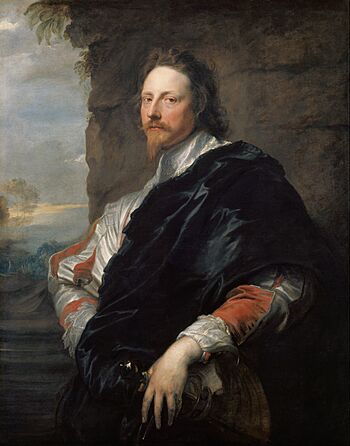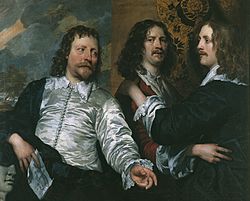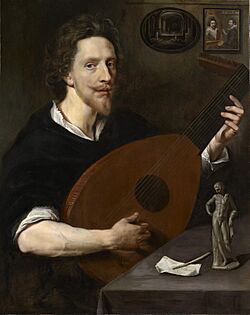Nicholas Lanier facts for kids

Nicholas Lanier (born 10 September 1588 – died 24 February 1666) was an important English composer and musician. He was the first person to be called the Master of the King's Music. This was a special honor given to very talented musicians, and he held the title from 1625 until he died in 1666.
Lanier was a court musician, meaning he worked for the King. He was a composer, performer, and also a Groom of the Chamber for King Charles I and King Charles II. Besides music, he was also a singer, played the lute, designed stage sets, and was a painter.
Contents
A Musician's Life
Early Years and Family
Nicholas Lanier came from a French family of royal musicians called the Lanière family. They were Huguenots, which means they were French Protestants. His family left France to escape danger and settled in England in 1561. Nicholas was born in Greenwich.
His father, John Lanier, taught him music. John played an instrument called the sackbut, which is like an old trombone. Nicholas's grandfather and great-grandfather were also musicians for the French King. His aunt, Emilia Bassano, was also from a family of musicians who worked for the English royal court.
Music and Court Life
In 1613, Nicholas Lanier helped create music for a special court show called a masque. He worked with other composers like Giovanni Coperario. He also wrote music, sang, and designed sets for other masques by famous writers like Thomas Campion and Ben Jonson.
In the 1610s, Lanier became a lutenist (a lute player) in the King's orchestra. He also sang in the King's Consorte, a group of musicians, from 1625 to 1642. He could also sing and play the viola da gamba, another old string instrument.
Travels and New Ideas
Starting in 1625, Lanier traveled to Italy many times. He went there to buy paintings for King Charles I. He even helped the King buy a large art collection from the Dukes of Mantua.
While in Italy, Lanier heard new kinds of music by composers like Claudio Monteverdi. This new Italian style included monody (music for a single voice with accompaniment) and recitative (a style of singing that sounds like speaking). Lanier was one of the first English composers to bring these new ideas back to England.
It was also Lanier who convinced the famous Flemish painter van Dyck to come to England. Van Dyck painted Lanier's portrait in Antwerp. This painting shows a relaxed and confident style called sprezzatura. This means making something difficult look easy and effortless. Van Dyck became the main court painter in England, and Lanier's portrait by him is now in Vienna.

Master of the King's Music
In 1626, Nicholas Lanier became the very first person to hold the title of Master of the King's Music. This important role is similar to the Poet Laureate, a special poet for the King.
During the time of the Commonwealth of England, when there was no king, Lanier lived in the Netherlands. But when King Charles II returned to the throne in 1660, Lanier also came back to England. He continued his duties and became the music master for King Charles II.
Lanier also designed many stage sets, including for Ben Jonson's play Lovers Made Men. We know of only one painting that Lanier himself made, which is a self-portrait (a painting of himself). It is kept at Oxford University. Nicholas Lanier died in 1666 in East Greenwich.
See also
- Lanier's family tree


